 A brochure for a fifth-grade class reading World War II novels. Novels are split into categories: The United States (homefront, the atomic bomb, and internment), The World (war in Asia and the Pacific, war in Europe, and “during and after the war” – a sort of catch-all category for books that deal more with the aftermath of WWII), The Holocaust, and The Resistance. Download the two-page PDF here.
A brochure for a fifth-grade class reading World War II novels. Novels are split into categories: The United States (homefront, the atomic bomb, and internment), The World (war in Asia and the Pacific, war in Europe, and “during and after the war” – a sort of catch-all category for books that deal more with the aftermath of WWII), The Holocaust, and The Resistance. Download the two-page PDF here.
Category: books
Review: Meet Wild Boars
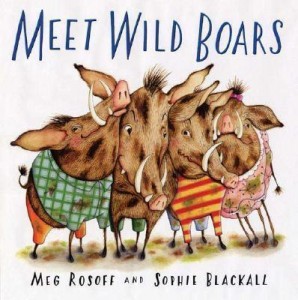 I don’t normally review picture books, but I wrote this one for school. This is one of my all-time favorite picture books – it’s so much fun for storytime.
I don’t normally review picture books, but I wrote this one for school. This is one of my all-time favorite picture books – it’s so much fun for storytime.
Meet Wild Boars, Meg Rosoff & Sophie Blackall
Meet Wild Boars is a picture book by Meg Rosoff, who is best known for her Printz Award-winning, controversial young adult novel How I Live Now. Meet Wild Boars is a huge departure from Rosoff’s work for older readers, but it is just as successful. This book does exactly what the title suggests: it introduces the reader to four wild boars, who are “dirty and smelly, bad-tempered and rude,†and who demonstrate their shockingly bad manners throughout the book. The boars – named Boris, Morris, Horace, and Doris – don’t like anyone, and they aren’t afraid to show it.
The first sign of their bad attitude is on the first page, which shows a young boy holding the door for Boris. Boris doesn’t say “thank you†– instead, he hits the boy with his tusks. Though Rosoff goes on to describe even more of the boars’ nasty behavior, the book later invites you to take pity on the boars. After all, “[n]obody loves them. Maybe just once they could come to your house.†A spread with five different pictures follows, showing the boars behaving nicely, as “[t]hey promise just this once they will try to be good.†Watch out, though – the boars will do no such thing. Instead, they’ll wreak havoc on your toilet, your puzzles, and your pets. Doris, who is the worst boar of all, may even “eat your very best whale, flippers and all.â€
Meet Wild Boars is a wonderfully funny book. Kids love stories about disgusting and badly behaved characters, and the boars featured here are both. The illustrations are detailed and delightful – the four boars have a lot of personality, which shows in their mismatched, ill-fitting clothing; dirty fur; and mischievous expressions. The facial expressions on the children are understated, but will often reflect the reader’s reaction. When Boris tusks the little boy, he looks pained. When the boars come over to the children’s house, the kids’ expressions of horror, rage, and disgust make clear how the reader should respond.
The story is paced well, with the first half devoted to an explanation of the boars’ history of bad behavior, and the second half describing the chaos that will ensue should you invite the boars to your own house. Humorous and detailed examples of the boars’ behavior are present throughout the story. One highlight is a full-page image of Doris. The facing page describes her: “She is STINKIER than a stinkpot turtle. She is UGLIER than an Ugli fruit. She is BOSSIER than a Bossysaurus.†The text here is representative of the rest of the book: simultaneously matter-of-fact and hyperbolic. The text is funny, but the image says it all. Doris – who is differentiated from her male counterparts by the tiny pink bow on her head – wears a dirty pink dress with green stink waves emanating from it. With her tail, she holds a hand mirror up to her dirty rear end, while she sniffs the rear end of the previously mentioned stinkpot turtle. At her feet are pools of brown sludge. Her messiness is unparalleled, and kids will get a kick out of the disgusting illustrations.
Throughout the book, the pictures do a wonderful job of bringing the text to life. On one two-page spread, the text reads, “Poor wild boars. Nobody loves them. Maybe just once they could come to your house.†In contrast to the fairly understated text, the picture shows the four boars racing gleefully toward the house of an unsuspecting young boy. Two of the boars are looking out at the reader with narrowed eyes and a crooked smile – they are clearly looking forward to destroying the boy’s house. The text and illustrations work together perfectly, creating a story that engages children on multiple levels. Many children who cannot read yet will enjoy looking at the pictures on their own after hearing the story.
This is a picture book with very broad appeal. The story is simple enough that kids as young as three can enjoy it, but the humor and clever illustrations will appeal to older siblings and parents, as well. There are a couple of jokes about bodily functions, which are always popular, and the extreme misbehavior of the boars will entertain even the most staid six-year-old. In general, children enjoy reading about the misbehavior of others, as it allows them to vicariously enjoy activities that are forbidden to them. It also gives children an opportunity to correct the behavior of others, which isn’t something they get to do very often. Anyone who likes David Shannon’s No, David! and its sequels will enjoy this tale of bad deeds and misbehavior.
Meet Wild Boars would be a great addition to any public library’s story time cabinet, thanks to its relatively short length and broad appeal. For that purpose, the one potential drawback of this book is the detail of the pictures. It would be ideal in a large book format., as many pages have multiple images, and the larger pictures have a lot of fun details. With that said, the pictures feature lots of bold colors and movement, so while children at a story time may not get to enjoy every detail of the pictures, they can certainly appreciate the story. The book offers a lighthearted contribution to a story hour about manners, as the boars provide a great example of how not to behave. The sequel, Wild Boars Cook, is just as good as the original. A program that included these two books and a no-bake cooking activity – perhaps something involving chocolate pudding and gummy worms – would be a fun, if messy, activity for pre-schoolers and their caregivers. Since the boars are all about getting messy, it only seems appropriate.
Review: Thirteen Reasons Why, by Jay Asher
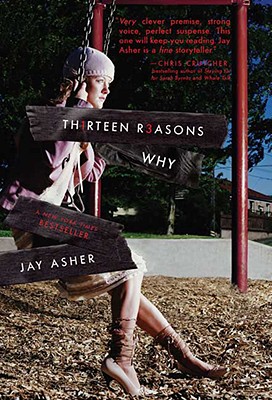 Th1rteen R3asons Why, Jay Asher
Th1rteen R3asons Why, Jay Asher
So I hate the dopey title, and I really wanted to hate the book. It’s such a contrived (if original) premise – girl leaves suicide mix-tapes for all the people who made her suicidal. And I’m not sure it’s especially well-executed; in particular, the parts of the novel that are narrated by Hannah (the tapes) in no way sound like dialogue, and that bothered me – after all, the author could’ve just had her write letters. My other initial hesitation was Hannah herself. I’ve had a couple of friends who have committed suicide, so to me that person looks different than Hannah, who is blonde and popular and, well, female. Add to that the fact that a few of her 13 choices seem downright petty, and I got mad at her for making people feel guilty for the rest of their lives because of an almost certainly unintended slight – 100 pages in, I was skeptical.
But it’s a weirdly moving novel, when it comes to it. It took me until the end of the book to appreciate it, but I did, and I was glad I read it. The protagonist’s part in Hannah’s suicide is heartbreaking, and the interactions he has with other recipients of the tapes are compelling and ring true – much more so than the contents of the tapes themselves. I like to see teenagers reading this book (and they do, in droves), for a host of reasons. I appreciate that Asher lays out (in a non-didactic fashion) many of the warning signs of severe depression, which is good information for kids to have. Even better, what this book teaches is the importance – in this case, a life-or-death level of importance – of treating other people kindly and with respect, all the time. A lot of the people Hannah blames for her suicide weren’t unusually mean, for high school kids. They were just callous and uncaring, and that was enough to hurt her. The more reinforcement that message gets, the better.
In short: For the win, in spite of the goofy title. A strong message and characters that teens will recognize from the hallways of their very own high schools make this a compelling read.
Read it if you like: Other “issue” YA novels, like (I’m going to date myself here) Cut and Smack
Review: The Penderwicks, by Jeanne Birdsall
 The Penderwicks, Jeanne Birdsall
The Penderwicks, Jeanne Birdsall
In short: Super-retro tale of children running free during summer vacation and getting into adorable kinds of “trouble”. The four sisters are well-drawn and endearing, even if they fall neatly into Boxcar Children-esque sibling stereotypes, and the people they encounter while on vacation are just quirky enough to be interesting. The novel is old-fashioned in its language and plot, so it is really jarring when all of a sudden the girls’ dad pulls out his laptop. How many parents in 2009 are trusting enough to let their kids run wild around an unfamiliar area? (I mean, I did that as a kid, but that was a good 15 years ago, and in a small town with zero crime.) Of course, the whole book is set in an incredibly wholesome alternate universe (the most scandalous this book gets is when the oldest sister develops an incredibly wholesome crush on an older boy), so this is a good choice for parents who have concerns about what their kids are reading.
All in all, this is a really cute story – I’m guessing it’ll be enjoyed more by adults who want to indulge in nostalgia than actual present-day children, but that happens.
Read it if you like: The Boxcar Children, other slightly dated children’s series
Author Encounters: Aaron Allston
So, for those of you who are not nerds, 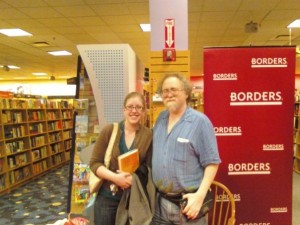 Aaron Allston is the author of a number of Star Wars novels – actually, he’s the author of all the good Star Wars novels (other than the ones written by Matthew Stover and Timothy Zahn, and maybe Michael Stackpole if I’m feeling generous). He’s awesome. So when I found out he’d be doing a book signing at the Oakbrook Borders, I knew I had to be there.
Aaron Allston is the author of a number of Star Wars novels – actually, he’s the author of all the good Star Wars novels (other than the ones written by Matthew Stover and Timothy Zahn, and maybe Michael Stackpole if I’m feeling generous). He’s awesome. So when I found out he’d be doing a book signing at the Oakbrook Borders, I knew I had to be there.
It was a pretty awesome scene: there were lots of people in costume, and a remote-controlled life-sized R2-D2. Most importantly, of course, there was Aaron Allston, who read some from Outcast (his new book, part of the new Fate of the Jedi series, which is liable to be pretty terrible but that’s not his fault) and then answered audience questions…including mine, which I’ll tell you about if you’re curious. Afterwards, we all lined up and got our books signed. He was really great and personable and happy to answer questions and chat a little. He wrote a personal note in everyone’s books. He even agreed to sign one kid’s stack of like eight books, which is unusual at these events.
So that was all pretty cool, but then it got awesome. Earlier in the evening, I’d been talking to some guys from the local Star Wars club, and they’d invited me to go out to dinner with their group after the signing. I was hungry – I’m always hungry – so I went, not knowing that – drumroll, please – Aaron Allston would be joining them.
WHAT.
For the record, I never wake up in the morning and think to myself, “Hey, I bet I’m going to have dinner with one of my favorite authors tonight.” Because that is not a thing that happens.
Except for tonight, when it totally did happen.
So anyway, we went to some sports bar-type place and had dinner and a drink with Aaron Allston, seriously, and we talked about Star Wars and lots of other stuff, like normal people, which we mostly are. It was an epically awesome night…which most of you know since I’m pretty sure I called everyone who could possibly care once I got home.
SUCCESS.
Review: The Grave, by James Heneghan
 The Grave, James Heneghan
The Grave, James Heneghan
This is another St. Patrick’s Day find, as it was the only YA book that popped up in our catalog under “Irelandâ€. The cover art is atrocious, but I’m always vaguely interested in books about Ireland, so I picked it up.
It was the right choice. Tom Mullen, a Liverpudlian foster kid, falls into a mysterious mass grave in 20th-century Liverpool and wakes up in Achill, an island off the west coast of Ireland, in the midst of the potato famine. This is of course a pretty bad place to find oneself, but Tom does swimmingly: within minutes he’s rescued one of the townspeople from drowning and is hailed as a hero (possibly of a supernatural order). Oddly enough, the kid he’s rescued is pretty much his doppelganger, which lends some credence in the villagers’ minds to the “supernatural” theory. Tom bunks with the Monaghans for a few days, befriends the oldest Monaghan brother, Brendan, who is disabled and reminds Tom of his co-foster-kid back home. He also falls in love with Hannah, the Monaghan daughter. He gets shunted back and forth between 1840s Ireland and 1970s Liverpool, facing tragedy and historically accurate hardship in both places, until he finally learns why he was sent back in time–and, in the process, learns valuable lessons about family and friendship (of course). I won’t reveal the ending, because it actually surprised me, and it’d be a shame for you to miss out on it.
The problem I had with this book—and it’s relatively minor—is that Tom sounds much older than he is. He’s only supposed to be twelve or thirteen, but his attitudes and vocabulary and interests seem at least three or four years older, and it’s kind of disconcerting. Obviously he’s supposed to be more worldly than your average adolescent, what with being a foster kid and all, but this goes beyond what can be accounted for by his status. I really enjoyed his voice and the writing generally, but in my head, Tom had to be fifteen to make it work.
In short: A well-written and compelling time-travel story. Its somewhat clichéd ending and message don’t detract from the power of the famine scenes, so it works in the end.
Read it if you like: Snarky British teenagers; the potato famine
Don’t take my word for it:Â Reader Rabid, Reading Matters
Review: Kathleen: The Celtic Knot, by Siobhán Parkinson
 Kathleen: The Celtic Knot, Siobhán Parkinson (Girls of Many Lands series)
Kathleen: The Celtic Knot, Siobhán Parkinson (Girls of Many Lands series)
So I picked this book up when I was making a St. Patrick’s Day display. I never read this series—or knew that it existed, actually—but it has a lot of the same charms of the original American Girl books. Kathleen is spunky, clever, and resourceful, taking care of her younger siblings and learning Irish dance in a Dublin tenement circa 1930-something. It’s a gentle, uplifting story, but there’s enough grittiness in Kathleen’s surroundings to stop the book from getting too syrupy. Towards the end, the plot weirdly echoes that of the Christmas Felicity book, but that might be a coincidence.
I appreciate that this book doesn’t try too hard to cater to its American audience. As a result, there are some references here that will be lost on the book’s target demographic—let’s face it, I’m better versed in Irish history than the average ten-year-old—but ideally, this is the kind of book that’ll encourage those kids to go and learn more. And I love how very Irish the book is—the writing and the dialogue are spot-on (at least, they sound just like twenty-first century Irish people; I obviously haven’t got a clue how people spoke in the 1930s, but at least they don’t sound American).
In short: Sweet, wholesome, educational—what you’d expect from an American Girl book.
Read it if you like: Irish culture and history; the other books in the series
Review: The Green Glass Sea, by Ellen Klages
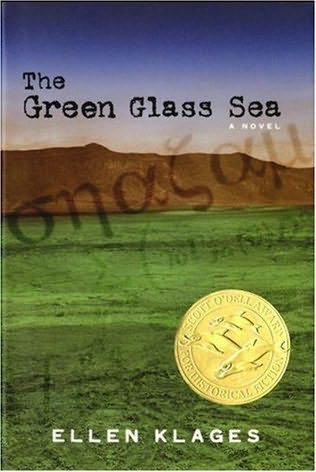 The Green Glass Sea, Ellen Klages
The Green Glass Sea, Ellen Klages
I liked this book. I suspect most children will not even give it a chance. Certainly there is absolutely no way that we could get the kids at our library to read it. (Evidence: before I checked it out, the book had gone out once–to a different library, through ILL.) This a shame, because The Green Glass Sea is really great historical fiction.
This book takes place from 1944-1945 at Los Alamos. Dewey, our heroine, is terrific and mad likable, particularly if you are/were a nerdy kid yourself. She’s living there with her scientist father–her mother is not in the picture–and having a grand old time asking for advice on her inventions from–oh man, was that Richard Feynman? Nuh-uh.
So okay, I geeked out a little. So does Dewey. Sadly, her strange, very personal utopia falls apart when her father is sent to Washington and she is left to stay with the Gordons, whose not-so-charming progeny is one of Dewey’s tormentors at school. Through a number of big events, both personal and historical, Dewey and Suze learn to navigate their relationship and the strange world into which they’ve been thrown. The two girls and Mrs. Gordon are wonderfully crafted characters, and the way the book deals with war–and with the devastating weapon its adults are building–is honest, nuanced, mature. The last chapter, in particular, is astonishing. It’s really good, you should read it!
In short:Â Great historical fiction that’s probably too old for most kids who are Dewey’s age–throw it to the YAs and the more mature tweens. Good news: there’s a sequel.
Read it if you like:Â Historical fiction, particularly about World War II; strong female protagonists
Review: The Book of Lost Things, by John Connolly
 The Book of Lost Things, John Connolly
The Book of Lost Things, John Connolly
This is one of those books that I knew was an objectively good book, but I didn’t actually enjoy reading it. (So, the opposite of The Au-pairs.)
The beginning of the book reminded me of all the other precocious pre-adolescents I’ve been reading about lately: twelve-year-old David is a bright, bookish English kid whose mother is dying during World War II. She kicks it early on, and he is then subjected to a stepmother, Rose, and a new baby brother. There’s a lot of whining and a little bit of family intrigue, as David moves into the bedroom of a little boy who disappeared decades ago. In the background is the war, which draws David’s father away from home, and creates plenty of tension in the house.
All this was fine and totally enjoyable, and of course right up my alley. However, the book quickly becomes very weird as David is transported to the world of fairy tales–and not the nice Disney-fied versions, either. He’s faced with any number of terrible creatures, from a tribe of half-wolf/half-humans (the story of their creation is the weirdest of all Connolly’s weird fairy-tale reinventions) to the Crooked Man, who really wants to eat David’s little brother. David embarks on a long, dangerous journey to meet the King–who turns out to be very Oz-like in a strange and kind of wonderful way–and is helped along the way by some interesting companions (including the Knight, who is on a suicide mission to find his dead lover, and the Woodsman, who is maybe God). There’s a discomforting hint of misogyny in a number of David’s encounters, which if you’re inclined to be generous can be read as David’s giving form to his wariness of his stepmother. I suspect it will bother some readers, though, so there’s your fair warning.
I will say that I’m not a fantasy person. If I suspect that a book will prominently feature dwarves or fairies, I do not read it. So this was outside my comfort zone, in that regard, and I’m sure that my prejudices affected my reading of the book. Still, the main problem for me was that I wasn’t expecting this book to be as gory as it was. There were too many graphic depictions of torture, dismemberment, decaying bodies and so on–I didn’t realize until after I’d finished the book that Connolly mostly writes crime thrillers. Had I known that, I probably wouldn’t have picked this book up. It’s just not my taste–but for those of you who have a love of gory thrillers, an active imagination, and a taste for the literary, this book would probably be great.
So in the end, did I like this book? I have no idea. I guess I did. I thought the ending was sad, and it made me tear up a bit. Of course, I was also relieved when it was over, so maybe I didn’t like it. Maybe you will.
In short: Though not for the faint of heart (or stomach), The Book of Lost Things is an entertaining, occasionally thought-provoking visit to the realm of childhood nightmares. Thanks a lot, John.
Read it if you like:Â The Wizard of Oz;Â the David Bowie movie Labyrinth, which I was reminded of on pretty much every page; that weird Sweet Valley Twins book where they go to the theme park and a witch tries to eat Jessica or something
Review: The After-Life, by Daniel Ehrenhaft
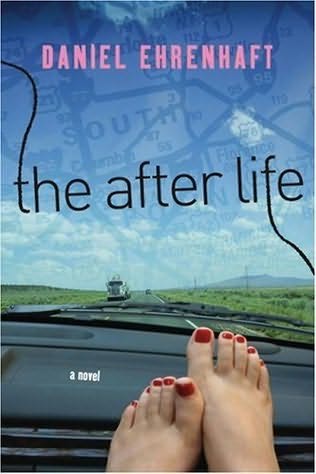 The After-Life, Daniel Ehrenhaft
The After-Life, Daniel Ehrenhaft
In short: A pretty good road-trip novel. It didn’t leave much of an impression, to be honest (I’m writing this review about six weeks after reading it, because…well, I forgot I’d read it). But I do remember enjoying it. The premise is that a messed-up alcoholic drop-out nineteen-year-old starts attending the private school where the half-siblings he’s never met (his dad ran out when he was a baby, and he hasn’t seen him since) also go to school. Upon matriculating, Will meets the half-siblings—twins Kyle and Liz—and, shortly thereafter, his long-absent father. Daddy then dies, sending the three kiddos on a road trip up the East Coast. They chat, they do drugs, they…well, mack a little bit. But it’s all good. And the first chapter—Will’s entrance essay for Kyle and Liz’s posh private school—is insanely funny. I liked it, and I suspect most of the teens who pick it up will, too—regardless of gender, for once.
Read it if you like: The Au-pairs, but don’t want to lose any more brain cells; debauchery; sexier updates of older YA road-trip novels, like my favorite, Joan Bauer’s Rules of the Road
